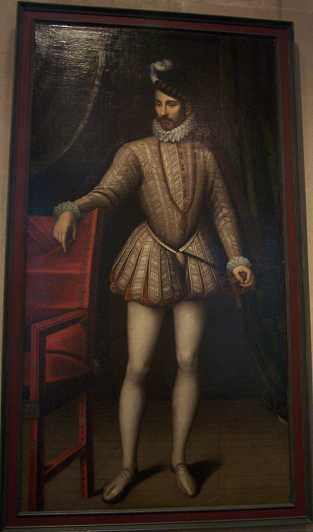| Catherine de Medici, studio of Francois Clouet (c.1522 -1572). |
| Charles IX, studio of Francois Clouet (c.1522 -1572). |
| Henri III, French school late 16th century |
| Mary Stuart (1542 - 1587), from the studio of Francois Clouet (1522 - 1572) |
| Procession of the Catholic League on the Place de Greve in 1590 or 1593 |
| Pont Neuf gargoyle |
| Place Royale/Place des Vosges around 1665 |
| part of a stained glass window |
| view from Pont Neuf around 1665-1669. |
| Procession de la confrerie de Saint-Michel-du-Mont, French school early 17th century |
| Mme Sevigne |
| Daughter of Mme Sevigne |
| Louis XIV visiting the Hotel Royal des Invalides (as it was then known), on 26th Agust 1706 |
| 17th century fireplace |
| Louis XVI in 1777 by Joseph-Siffrède Duplessis (1725-1802) |
| A music room in the style popular during the reigns of Louis XV and Louis XVI. |
| Detail of above |
| Erection of the obelisk from Luxor in the Place de la Concorde on 25th October 1836, by Francois Dobois (1790 - 1871) |
| Le Moulin de la Galette a Montmartre by Eugene Ciceri (1813 - 1890) |
| Le Pont Marie et le quai Saint-Paul by Charles Mozin (1806 - 1862) |
| L'eglise Saint-Pierre de Montmartre, 1931 by Maurice Utrillo (1883 - 1955). |
| The bedroom of Marcel Proust |
| The ballroom of the Hotel de Wendel 1934 - 5, by Jose-Maria Sert (1876 - 1945) |
| Juliette Greco 1956, by Robert Humblot. |
|
Francois Clouet
On the right is Catherine de Medici (1519 - 1589), from the studio of Francois Clouet (c.1522-1572). In 1533 she married the future Henri II. She was widowed in 1559, and became regent for her two sons, Francis II and Charles IX (see below), and advisor to her thrid son Henry III (see below). She was the daughter of a wealthy Florentine banker. She had a country house in what is Trocadero today in the 16th, but at that time is was just cottages surrounded by vinyards.
Below right is Charles IX, the son of Catherine de Medici on the right, also from the studio of Francois Clouet (c.1522-1572).
Charles IX was her second son, and he became king in 1560 when he was 10, and reigned until 1574. On passing by a scaffold holding the rotting remains of the Protestant Colingny, who had been hanged during the Saint Bartholemew's massacre, Charles is reported to have said, "The body of a dead enemy never smells bad." |
 |
|

Details from a stained glass window. |
 |
|
 |
On the left is Henri III, French school late 16th century, the third son of Catherine de Medici to be king of France.
On the right is Mary Stuart (1542 - 1587), from the studio of Francois Clouet (1522 - 1572). She was married to Francis II, and after he died she returned to her native Scotland where, according to Dr Johnson, she had the "manners and morals of an hysterical poodle on heat".
Eventually she was beheaded in England by Elizabeth I after having been prisoner for some years and constantly plotting to dethrone Elizabeth and put herself on the English throne. After the natural death of Elizabeth, Mary's son, with her second husband, untited the kingdoms of England and Scotland under one monarch.
Return to the 3rd arrondissement. |
 |
|
The painting on the right shows the procession of the Catholic League on the Place de Greve in 1590 or 1593. It was a time of great religious turmoil in Europe. This painting is particularly interesting as it shows what life in Paris was like at that time. Note the water seller carrying her buckets on the left, and the soup seller and butcher. In the distance you can see the start of the building of the Hotel de Ville. Also note the gallows where any executions would take place.
|

|
 |
copyright2003-2012 |
|
VIETNAM PAGES
WINDOWBOX
GARDENING
ApartRental Paris
|










